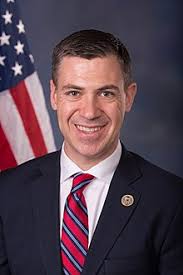
(WASHINGTON, D.C.) – The National Defense Authorization Act passed the House of Representatives and awaits action in the Senate. Rep. Jim Banks sits on the House Armed Services Committee which is responsible for authorizing funding levels for the military. Over the past several months, Rep. Banks has served on the NDAA Conference Committee, which is responsible for reconciling differences between the House and Senate versions of the bill. Throughout this process, Rep. Jim Banks was able to fight to ensure that the Fiscal Year 2020 NDAA delivers on Indiana’s defense priorities.

“I’m proud of the final bill and conference report that passed in the House today. With this bill, Indiana will continue to be a hub for defense research and manufacturing,” said Rep. Jim Banks. “My colleagues on the Conference Committee worked together to bridge many of the gaps that made the original bill overly partisan and threatened our national security. Our work is not over; we need to continue to look to the future and develop new, innovative technologies.”
Hoosier Priorities included in FY20 NDAA:
- Hypersonics Transition Office – Strengthens the partnership between the Department of Defense and universities by creating a hypersonics consortium. Purdue University and Notre Dame are leaders in these capabilities.
- Funding for Sonobuoys – Exceeded the president’s FY20 budget funding request for sonobuoys by $50 million. Many of the United States’ sonobuoys are produced in Columbia City, Indiana.
- Defense Research Security – Requires the Secretary of Defense to establish enhanced information sharing procedures to collect appropriate information on any personnel participating in defense research and development activities other than basic research and to maintain appropriate security controls over research activities, technical information and intellectual property. This portion of the NDAA was inspired by Rep. Jim Banks’ legislation, H.R. 1678, Protect Our Universities Act.
- Military Spouse License Reciprocity – Seeks to improve the portability of occupational licenses and certifications from state to state. This will help alleviate the burden military spouses bear when having to re-register a small business in a new state each time a service member gets reassigned to a military installation in a new state.
- Interagency Program Office / Federal Electronic Health Record Modernization (FEHRM) – Sets qualification requirements for the Interagency Program Office / FEHRM director and deputy director, and instructs the Secretary of Defense and Secretary of Veterans Affairs to appoint them jointly. Aims to strengthen coordination between Department of Defense and the Department of Veterans Affairs on electronic health records.
- Network of Veteran Support – Creates a network of support for servicemembers and their families. These networks are intended to improve servicemembers’ mental health by engaging directly with families on the challenges servicemembers experience, potentially preventing isolation and suicide.
Key Provisions in FY20 NDAA
- Space Force – The NDAA recognizes space as a warfighting domain and establishes the United States Space Force as the sixth Armed Service of the United States under the Air Force — the first new branch of the military since 1947 and a priority of President Trump.
- 3.1% Pay Raise – The FY20 NDAA supports a 3.1 percent pay raise – the largest increase in a decade – and extends special pay and bonuses for service members. It also doubles the reimbursement allowance for professional licenses, takes steps to remedy child-care waitlist backlogs on military bases, and improves the moving process.
- Repeals the Widow’s Tax – The NDAA includes a fiscally responsible, three-year phased repeal of the requirement that Survivor Benefit Plan payments be reduced by Dependency and Indemnity Compensation payments.
- Nuclear Modernization – The NDAA fully funds our nuclear modernization efforts across all legs of the triad and allows DOD to deploy low-yield nuclear weapons and increase plutonium pit production.



